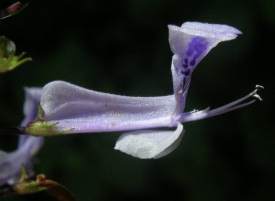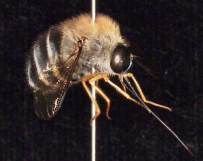Plectranthus zuluensis
Plectranthus zuluensis T.Cooke
Family: Lamiaceae
Common names: Zulu spurflower ( Eng. ); Zoeloespoorsalie, Zoeloemuishondblaar (Afr.).
Introduction
The delicate blue flowers and velvety leaves of Plectranthus zuluensis make this easily grown shrub a winner for those difficult shady areas in summer rainfall gardens.

Description
Description
Plectranthus zuluensis is an erect or sprawling, soft shrub up to 2 m high, with much-branched, four-angled, hairy stems which are velvety to the touch when young. Soft, semi-succulent leaves are ovate with coarsely toothed margins and covered with tiny, colourless glands. The plant has a characteristic pungent smell when crushed.

Inflorescences, borne at the ends of the branchlets, are 60 to 100 mm long and bear the flowers in whorls of six. The 6 mm long calyx is saccate (wide) at the base, narrowing towards the throat, and ranges from deep purple-blue to pale blue-mauve, with six rows of mauve dots along the upper lip. This species is unusual in the genus Plectranthus as the upper pair of stamens are sterile. The main flowering time is from October to June with a peak in April. Fruit are small, dark brown nutlets.
Attractive cultivars of this species are Oribi Gorge with light purple-blue flowers, Sky, a low-growing (1 m) shrub with dark purple-blue flowers, and Umgai, a taller (2 m) shrub with dark purple-blue flowers.
Conservation Status
Status
Plectranthus zuluensis is not threatened.
Distribution and habitat
Distribution description
Plectranthus zuluensis occurs from the northern parts of the Eastern Cape through the coastal region of KwaZulu-Natal to southern Swaziland, all of which are summer rainfall areas that experience little or no frost. The species is often common along stream banks and deep river gorges in humus-rich soil and in shady or semi-shady areas on the margins of semi-coastal, subtropical forests. It is best suited to gardens in warmer, frost-free areas.
Derivation of name and historical aspects
History
Plectranthu belongs to the Lamiaceae or mint family, members of which are usually highly aromatic due to the presence of essential oils, and include such well-known culinary herbs as lavender, rosemary and thyme. There are about 300 species in the genus Plectranthus, of which ± 48 occur in South Africa, mostly in the eastern regions. The name Plectranthus is derived from the Greek plektron, meaning spur, and anthos, meaning flower. The specific name zuluensis refers to its distribution in Zululand (now part of KwaZulu-Natal ). First collected by William Gerrard, an English naturalist, and described by T.Cooke in 1909, it was almost 50 years before P. zuluensis was first introduced to horticulture. In the mid 1900s, a specimen collected by R.A.Dyer in the Krantzkop District, was grown at the Botanical Research Institute in Pretoria.
Ecology
Ecology

Plectranthus flowers produce large amounts of nectar, attracting many insects which transfer pollen between flowers. A study of the pollination biology of this group at the University of KwaZulu-Natal (Potgieter et al. 1999) showed a correlation between floral tube length and proboscis length of insect visitors. They observed that the most important pollinator of P. zuluensis is a long-tongued fly (Psilodera confusa, Acroceridae) which has a proboscis length similar to that of the flower tube. Insect visits to the flowers follow a pattern, with lowermost flowers visited first and the upper ones next. As the receptive stigma protrudes beyond the pollen-bearing anthers, pollen from another flower is deposited onto the stigmatic surface before the insect picks up pollen as it leaves. This minimizes the chance of self-pollination. Pollen is picked up on the lower surfaces of the insect, and is thus ideally placed for deposition onto the stigma of the next flower visited. The larval stages of Psilodera spp. are parasitic on spiders, highlighting the complex and often poorly understood interactions between organisms, and emphasizing the need for the conservation of sufficiently large areas of natural vegetation to support pollination systems.
P. zuluensis is often found in association with at least six other species of Plectranthus, and natural hybrids between this species and P. ciliatus and P. saccatus have been observed in the wild. Viljoen et al. (2006) carried out a study to determine if essential oil chemistry could be used to confirm hybridization in Plectranthus. Their results showed that essential oil chemistry is in support of morphological data and pollination studies, which have indicated a natural hybrid between P. ciliatus and P. zuluensis. The hybrid plant contains terpenoids from both putative parents together with F hybrid compounds, which are not present in any of the two parents.
Uses
Use
There are no records of Plectranthus zuluensis being used in traditional healing.
It is a popular garden plant in KwaZulu-Natal as it grows well in difficult shady areas.

© T Edwards
Growing Plectranthus zuluensis
Grow
Plant as a shrubby groundcover under trees with Clivia, Crinum moorei, Scadoxus multiflorus var. katherinae, Streptocarpus and Thunbergia natalensis for a wonderful forest glade display. Prune into low, clipped hedges in more formal semi-shaded areas, and use in containers on verandahs and shady areas of the garden.
Propagation : Plectranthus spp. are very easy to propagate by cuttings with no specialized training or rooting hormones required! Cuttings can be taken at any time, but spring and early summer are best for quick results.Choose healthy plants and take softwood cuttings from the growing points. Use a sharp, clean instrument to cut approximately 0.5 m lengths from just below a node, and remove most of the leaves to reduce water loss. Keep cuttings moist and set as soon as possible in a clean, fast-draining medium such as sand or vermiculite. Place in a well-ventilated, shady position and water daily, or more if required in very hot weather. Roots will develop in 3 to 4 weeks, when the cuttings can be transferred to containers filled with potting medium. As Plectranthus grows so easily from cuttings, seed is not often used for propagation. Sow the fine seed in early summer, distributing it sparsely on the suface of a prepared seedling tray and cover with a thin layer of fine medium. Water regularly until the seedlings are ready to be potted on, after about three weeks.
Cultivation : Grow in humus-rich, well-drained, acid soil in shady to semi-shady conditions (in very humid regions it can be grown in full sun). Once established, plants need little watering. Feed with 2:3:2 every three months in summer to keep plants healthy. Prune plants every year after flowering to remove dead and diseased wood. Plants trained as hedges or shaped bushes should be kept trimmed to maintain a compact shape. Container plants need replacing annually. Water pots twice a week and feed fortnightly with a liquid fertilizer.
Pests : Eelworms can be a problem. These tiny worms live in the soil and attack the root system. Take cuttings of the plants and remove and burn roots of affected pants. Nematicides are available commercially, but handle these with care as they are usually highly poisonous. Most insects avoid Plectranthus plants, possibly because the high essential oil content of the leaves makes them unpalatable. Rust and blight are fungal diseases which do occasionally attack the plants, but these can be controlled by spraying with appropriate fungicides.
References
- Codd, L.E. 1985. Lamiaceae. Flora of southern Africa, 28,4: 167, 168. Botanical Research Institute, Pretoria.
- Dyer, R.A. & Bruce, E.A. 1951. Plectranthus zuluensis. The Flowering Plants of Africa 28: t. 1110.
- Hankey, A., 1999. The genus Plectranthus (Lamiaceae) in South Africa : diagnostic characters and simple field keys.Plant Life 21: 5-15.
- Pooley, E. 1998. A field guide to wildflowers of KwaZulu-Natal and the Eastern Region. Natal Flora Publications Trust, Durban.
- Potgieter, C.J., Edwards, T.J., Miller, R.M. & Van Staden, J. 1999. Pollination of seven Plectranthus species (Lamiaceae) in southern Natal, South Africa.Plant Sysematics and Evolution 218: 99-112.
- Van Jaarsveld, E. 1987. The Plectranthus handbook. National Botanic Gardens, Cape Town.
- Van Jaarsveld, E. 2006. The South African Plectranthus and the art of turning shade into glade. Fernwood Press, Cape Town.
- Viljoen A.M., Demirci, B., Baser, K.H.C., Potgieter, C.J. & Edwards, T.J. 2006. Microdistillation and essential oil chemistry-a useful tool for detecting hybridisation in Plectranthus (Lamiaceae).South African Journal of Botany 72: 99-104.
Credits
Isabel Johnson
KwaZulu-Natal National Botanical Garden
January 2007
Plant Attributes:
Plant Type: Shrub
SA Distribution: KwaZulu-Natal
Soil type: Sandy, Loam
Flowering season: Spring, Autumn, Winter, Sporadic/All year
PH: Acid, Neutral
Flower colour: Blue, Mauve/Lilac
Aspect: Shade
Gardening skill: Average
Special Features:
Horticultural zones







Rate this article
Article well written and informative
Rate this plant
Is this an interesting plant?
Login to add your Comment
Back to topNot registered yet? Click here to register.